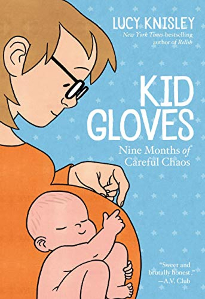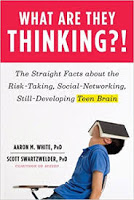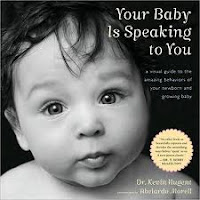the Straight Facts about the Risk-Taking, Social-Networking, Still-Developing Teen Brain
by Aaron M. White and Scott Swartzwelder
I got this book because of a concerned email from the public school administration (two months ago) sent to make parents aware of the new film Thirteen Reasons Why which was probably going to be popular among curious teens, and why it was so alarming. I haven\’t read the book or seen the film (nor do I want to), but I\’ve heard about it. I don\’t think my pre-teen has any interest in it either, but I\’m sure she will be exposed to the ideas of peers who have, and it\’s always best to arm yourself with knowledge. I don\’t often read self-help or parenting type books, but I went to the library looking for something about how to talk with teenagers about suicide. (My daughter is not suicidal. But I\’m sure she will hear other kids talking about it in regards to this film).
The book didn\’t really give me that, but it was very informative in a different way. It\’s about how the brains of adolescents are still developing, in ways that make them eager to show off and take risks, short-sighted when it comes to planning, often unable to control strong emotional reactions, easily stressed, and quick to learn new habits which can be lifelong. It goes into a lot of detail about the actual structure of the brain and how connections are being made and how certain behaviors, food intake, sleep patterns and substance use affects the brain during this developmental stage. Alcohol and drug use are particularly scary. In a nutshell, the book discusses: mental health issues, sugar and caffeine, eating disorders, sleep habits (our local school system starts high school latest of all, and now I know why), driving (how the brain learns and manages that multitasking skill, how easily it is distracted, exactly what aspects of teens driving are risky), influences of digital media on the brain, sexuality, exposure to violence and drugs.
That\’s a lot to take in. The authors are a biological psychologist and a neuropsychologist. They quote a lot of research and studies, but keep it brief and easy to understand. There is not a lot in the way of what-to-do when your kid acts a certain way, or how to talk with them about things- it\’s more about understanding how their still-developing mind affects their emotional reactions, thought processes, how they learn and make choices- so you get an idea of what\’s going on and are not taken unawares. It does point out a lot of warning signs: when to recognize your teen is just being a teen going through normal ups and downs, and when they are showing signs of something you need to address (ie a mental health disorder or substance abuse).
On a kind of side note, one little tidbit I found really interesting: in one state the brain goes through while in process of falling asleep, \”some people experience hypnagogic hallucinations during this stage, seeing imaginary objects or people in the room.\” It is common in young children and diminishes with age. So when your kid is frightened at seeing a monster in the corner or thinking of ghosts in the closet- they may actually be experiencing a minor hallucination when on the verge of falling asleep! On another note, I was kind of surprised at how abruptly the chapter on drugs ended. It discussed a lot of substances in succinct detail- telling what they physically do to the brain, how addictive they are, and how dangerous. The part about cocaine didn\’t mention anything about actual damaging affects to the body. Which I was expecting, because it was included in all the other sections.
Borrowed from the public library.
Rating: 3/5 288 pages, 2013











